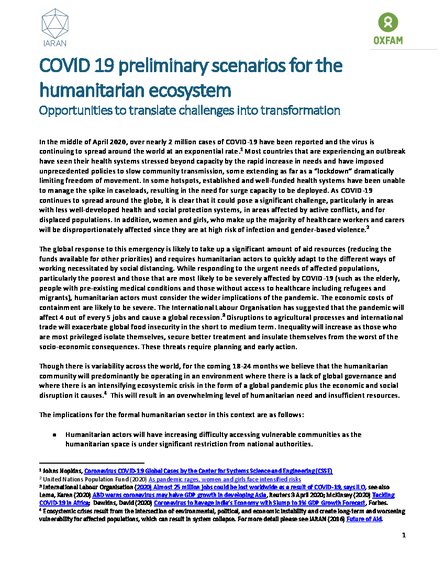
In the middle of April 2020, over nearly 2 million cases of COVID-19 have been reported and the virus is continuing to spread around the world at an exponential rate. Most countries that are experiencing an outbreak have seen their health systems stressed beyond capacity by the rapid increase in needs and have imposed unprecedented policies to slow community transmission, some extending as far as a “lockdown” dramatically limiting freedom of movement. In some hotspots, established and well-funded health systems have been unable to manage the spike in caseloads, resulting in the need for surge capacity to be deployed.
As COVID-19 continues to spread around the globe, it is clear that it could pose a significant challenge, particularly in areas with less well-developed health and social protection systems, in areas affected by active conflicts, and for displaced populations. In addition, women and girls, who make up the majority of healthcare workers and carers will be disproportionately affected since they are at high risk of infection and gender-based violence.
The global response to this emergency is likely to take up a significant amount of aid resources (reducing the funds available for other priorities) and requires humanitarian actors to quickly adapt to the different ways of working necessitated by social distancing. While responding to the urgent needs of affected populations, particularly the poorest and those that are most likely to be severely affected by COVID-19 (such as the elderly, people with pre-existing medical conditions and those without access to healthcare including refugees and migrants), humanitarian actors must consider the wider implications of the pandemic. The economic costs of containment are likely to be severe. The International Labour Organisation has suggested that the pandemic will affect 4 out of every 5 jobs and cause a global recession. Disruptions to agricultural processes and international trade will exacerbate global food insecurity in the short to medium term. Inequality will increase as those who are most privileged isolate themselves, secure better treatment and insulate themselves from the worst of the socio-economic consequences. These threats require planning and early action.
Though there is variability across the world, for the coming 18-24 months we believe that the humanitarian community will predominantly be operating in an environment where there is a lack of global governance and where there is an intensifying ecosystemic crisis in the form of a global pandemic plus the economic and social disruption it causes.This will result in an overwhelming level of humanitarian need and insufficient resources.
The implications for the formal humanitarian sector in this context are as follows:
● Humanitarian actors will have increasing difficulty accessing vulnerable communities as the humanitarian space is under significant restriction from national authorities.
● While formal humanitarian actors possess the capacity and expertise to engage in localized crises, limited experience in managing transnational/complex responses and in adopting equitable and effective remote partnering practices reduces their relevance when faced with a deepening ecosystemic crises which requires both local early action and collaborative longer-term strategies.
● Even where formal humanitarian sector actors have the knowledge and expertise, they are overwhelmed by the scale of need as funding for humanitarian action does not keep pace, leading to situations of high and prolonged distress.
● INGOs are struggling to adapt quickly enough to maintain their relevance as they are being superseded by national and regional actors.
● Global development assistance is not seen as a priority by many states and, an increasing number of private donors are focusing on domestic issues. International funding is primarily funnelled through bilateral aid between governments.
